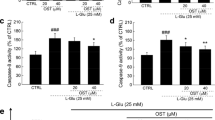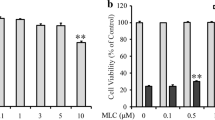Abstract
Alzheimer's disease (AD) is the most common form of dementia. Oxidative stress is one of the earliest events in the neurological and pathological changes of AD. l-3-n-butylphthalide (l-NBP), an anti-cerebral ischemia agent, has been shown a potential in AD treatment. In this study, we investigated the neuroprotective effect of l-NBP on hydrogen peroxide (H2O2)-induced apoptosis in human neuroblastoma SK-N-SH cells. H2O2 significantly reduced cell viability and increased the number of apoptotic-like cells, indicating that H2O2 induced neurotoxicity. In addition, real-time PCR and western blot studies showed that Bcl-2 and Bcl-w expressions were decreased, and Bax expression was increased with H2O2 treatment. Moreover, protein kinase C (PKC) α expression was down-regulated after H2O2 treatment. All of these phenotypes induced by H2O2 were markedly reversed by l-NBP. Pretreatment with l-NBP significantly increased cell viability of H2O2-damaged cells, and reduced H2O2 -induced neuronal apoptosis. l-NBP treatment at dose of 10 μM inhibited H2O2-induced down-regulation of Bcl-2, Bcl-w, and PKCα but also attenuated the overexpression of Bax. PKC inhibitor, calphostin C, significantly attenuated the protective effects of l-NBP. Our findings suggest that l-NBP may protect neurons against H2O2-induced apoptosis by modulating apoptosis-related genes and activating PKCα pathway.







Similar content being viewed by others
References
Adams JM, Cory S (1998) The Bcl-2 protein family: arbiters of cell survival. Science 281:1322–1326
Bissonnette CJ, Klegeris A, McGeer PL, McGeer EG (2004) Interleukin 1alpha and interleukin 6 protect human neuronal SH-SY5Y cells from oxidative damage. Neurosci Lett 361:40–43
Blagosklonny MV, Giannakakou P, El-Deiry WS, Kingston DG, Higgs PI, Neckers L, Fojo T (1997) Raf-1/bcl-2 phosphorylation: a step from microtubule damage to cell death. Cancer Res 57:130–135
Boscoboinik D, Szewczyk A, Hensey C, Azzi A (1991) Inhibition of cell proliferation by alpha-tocopherol. Role of protein kinase C. J Biol Chem 266:6188–6194
Chandra J, Samali A, Orrenius S (2000) Triggering and modulation of apoptosis by oxidative stress. Free Radic Biol Med 29:323–333
Chang Q, Wang XL (2003) Effects of chiral 3-n-butylphthalide on apoptosis induced by transient focal cerebral ischemia in rats. Acta Pharmacol Sin 24:796–804
Chen X, Zhang Q, Cheng Q, Ding F (2009) Protective effect of salidroside against H2O2-induced cell apoptosis in primary culture of rat hippocampal neurons. Mol Cell Biochem 332:85–93
Cory S, Adams JM (2002) The Bcl2 family: regulator of the cellular life-or-death switch. Nat Rev Cancer 2:647–656
Culmsee C, Landshamer S (2006) Molecular insights into mechanisms of the cell death program: role in the progression of neurodegenerative disorders. Curr Alzheimer Res 3:269–283
Frederikse PH, Garland D, Zigler JS Jr, Piatigorsky J (1996) Oxidative stress increases production of beta-amyloid precursor protein and beta-amyloid (Abeta) in mammalian lenses, and Abeta has toxic effects on lens epithelial cells. J Biol Chem 271:10169–10174
Ito T, Deng X, Carr B, May WS (1997) Bcl-2 phosphorylation required for anti-apoptosis function. J Biol Chem 272:11671–11673
Livak KJ, Schmittgen TD (2001) Analysis of relative gene expression data using real-time quantitative PCR and the 2−ddCt method. Methods 25:402–408
Ma SP, Xu SF, Liu B, Li J, Feng N, Wang L, Wang XL (2009) Long-term treatment of l-3-n-butylphthalide attenuated neurodegenerative changes in aged rats. Naunyn-Schmiedeberg’s Arch Pharmacol 379:565–574
Misonou H, Morishima-Kawashima M, Ihara Y (2000) Oxidative stress induces intracellular accumulation of amyloid beta-protein (Abeta) in human neuroblastoma cells. Biochemistry 39:6951–6959
Nishizuka Y (1988) The molecular heterogeneity of protein kinase C and its implications for cellular regulation. Nature 334:661–665
Nunomura A, Perry G, Aliev G, Hirai K, Takeda A, Balraj EK, Jones PK, Ghanbari H, Wataya T, Shimohama S, Chiba S, Atwood CS, Petersen RB, Smith MA (2001) Oxidative damage is the earliest event in Alzheimer disease. J Neuropathol Exp Neurol 60:759–767
Pastorino JG, Chen ST, Tafani M, Snyder JW, Farber JL (1998) The overexpression of Bax produces cell death upon induction of the mitochondrial permeability transition. J Biol Chem 273:7770–7775
Peng Y, Lee DY, Jiang L, Ma Z, Schachter SC, Lemere CA (2007a) Huperzine A regulates amyloid precursor protein processing via protein kinase C and MAP kinase pathways in SK-N-SH cells over-expressing wild-type human APP695. Neuroscience 150:386–395
Peng Y, Xu S, Chen G, Wang L, Feng Y, Wang X (2007b) l-3-n-Butylphthalide improves cognitive impairment induced by chronic cerebral hypoperfusion in rats. J Pharmacol Exp Ther 321:902–910
Peng Y, Xing CH, Lemere CA, Chen GQ, Wang L, Feng YP, Wang XL (2008) l-3-n-Butylphthalide ameliorates beta-amyloid-induced neuronal toxicity in cultured neuronal cells. Neurosci Lett 434:224–229
Peng Y, Xing CH, Xu SF, Lemere CA, Chen GQ, Liu B, Wang L, Feng YP, Wang XL (2009) l-3-n-Butylphthalide improves cognitive impairment induced by intracerebroventricular infusion of amyloid-beta peptide in rats. Eur J Pharmacol 621:38–45
Peng Y, Sun J, Hon S, Nylander AN, Xia W, Feng Y, Wang X, Lemere CA (2010) l-3-n-Butylphthalide improves cognitive impairment and reduces amyloid-beta in a transgenic model of Alzheimer's disease. J Neurosci 30:8180–8189
Perry G, Nunomura A, Cash AD, Taddeo MA, Hirai K, Aliev G, Avila J, Wataya T, Shimohama S, Atwood CS, Smith MA (2002) Reactive oxygen: its sources and significance in Alzheimer disease. J Neural Transm Suppl (62):69–75
Polster BM, Fiskum G (2004) Mitochondrial mechanisms of neural cell apoptosis. J Neurochem 90:1281–1289
Pratesi G, Polizzi D, Perego P, Dal Bo L, Zunino F (2000) Bcl-2 phosphorylation in a human breast carcinoma xenograft: a common event in response to effective DNA-damaging drugs. Biochem Pharmacol 60:77–82
Reddy VP, Zhu X, Perry G, Smith MA (2009) Oxidative stress in diabetes and Alzheimer's disease. J Alzheimers Dis 16:763–774
Reyland ME (2009) Protein kinase C isoforms: multi-functional regulators of cell life and death. Front Biosci 14:2386–2399
Ruvolo PP, Deng X, Carr BK, May WS (1998) A functional role for mitochondrial protein kinase C alpha in Bcl2 phosphorylation and suppression of apoptosis. J Biol Chem 273:25436–25442
Sakai H, Yamamoto M, Chiba Y, Misawa M (2009) Some different effect of PKC inhibitors on the acetylcholine, and endothelin-1-induced contractions of rat bronchial smooth muscle. Eur J Pharmacol 618:58–62
Schmittgen TD, Zakrajsek BA (2000) Effect of experimental treatment on housekeeping gene expression: validation by real-time, quantitative RT-PCR. J Biochem Biophys Methods 46:69–81
Smith MA, Richey Harris PL, Sayre LM, Beckman JS, Perry G (1997) Widespread peroxynitrite-mediated damage in Alzheimer's disease. J Neurosci 17:2653–2657
Wang R, Xiao XQ, Tang XC (2001) Huperzine A attenuates hydrogen peroxide-induced apoptosis by regulating expression of apoptosis-related genes in rat PC12 cells. NeuroReport 12:2629–2634
Wang C, Ma H, Zhang S, Wang Y, Liu J, Xiao X (2009) Safflor yellow B suppresses pheochromocytoma cell (PC12) injury induced by oxidative stress via antioxidant system and Bcl-2/Bax pathway. Naunyn-Schmiedeberg’s Arch Pharmacol 380:135–142
Weinreb O, Bar-Am O, Amit T, Chillag-Talmor O, Youdim MB (2004) Neuroprotection via pro-survival protein kinase C isoforms associated with Bcl-2 family members. FASEB J 18:1471–1473
Yang JS, Chen YW (1984) Separation and identification of effective anticonvulsant constituent in Apium graveolens L. Yao Xue Xue Bao 19:670–671
Yin ST, Tang ML, Deng HM, Xing TR, Chen JT, Wang HL, Ruan DY (2009) Epigallocatechin-3-gallate induced primary cultures of rat hippocampal neurons death linked to calcium overload and oxidative stress. Naunyn-Schmiedeberg’s Arch Pharmacol 379:551–564
Yu SR, You SQ (1984) The anticonvulsant action of 3-n-butylphthalide (Ag-1) and 3-n-butyl-4, 5-dihydrophthalide (Ag-2). Yao Xue Xue Bao 19:566–570
Zhao M, Eaton JW, Brunk UT (2001) Bcl-2 phosphorylation is required for inhibition of oxidative stress-induced lysosomal leak and ensuing apoptosis. FEBS Lett 509:405–412
Acknowledgement
This study was supported by the grants from National Natural Sciences Foundation of China (No. 30973511), Natural Science Foundation of Beijing (No. 7093125), and National S&T Major Special Project on Major New Drug Innovation of China (2009ZX09303-003; 2008ZX09401-004).
Author information
Authors and Affiliations
Corresponding author
Additional information
Ying Peng and Yanli Hu contributed equally to this work.
Rights and permissions
About this article
Cite this article
Peng, Y., Hu, Y., Feng, N. et al. l-3-n-butylphthalide alleviates hydrogen peroxide-induced apoptosis by PKC pathway in human neuroblastoma SK-N-SH cells. Naunyn-Schmied Arch Pharmacol 383, 91–99 (2011). https://doi.org/10.1007/s00210-010-0575-9
Received:
Accepted:
Published:
Issue Date:
DOI: https://doi.org/10.1007/s00210-010-0575-9




